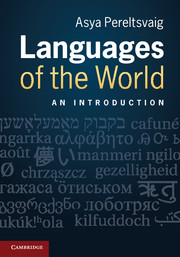Book contents
- Frontmatter
- Contents
- Figures
- Maps
- Tables
- Words, words, words…
- Acknowledgements
- Abbreviations used in the glosses
- 1 Introduction
- 2 Indo-European languages
- 3 Non-Indo-European languages of Europe and India
- 4 Languages of the Caucasus
- 5 Languages of Northern Africa, Middle East and Central Asia
- 6 Languages of sub-Saharan Africa
- 7 Languages of eastern Asia
- 8 Languages of the South Sea Islands
- 9 Aboriginal languages of Australia and Papua New Guinea
- 10 Native languages of the Americas
- 11 Macro families
- 12 Pidgins, creoles and other mixed languages
- Glossary
- References
- Index of languages
- Index of terms
5 - Languages of Northern Africa, Middle East and Central Asia
- Frontmatter
- Contents
- Figures
- Maps
- Tables
- Words, words, words…
- Acknowledgements
- Abbreviations used in the glosses
- 1 Introduction
- 2 Indo-European languages
- 3 Non-Indo-European languages of Europe and India
- 4 Languages of the Caucasus
- 5 Languages of Northern Africa, Middle East and Central Asia
- 6 Languages of sub-Saharan Africa
- 7 Languages of eastern Asia
- 8 Languages of the South Sea Islands
- 9 Aboriginal languages of Australia and Papua New Guinea
- 10 Native languages of the Americas
- 11 Macro families
- 12 Pidgins, creoles and other mixed languages
- Glossary
- References
- Index of languages
- Index of terms
Summary
In the previous chapter, we discussed languages of the Caucasus; in this chapter, we are moving to the region immediately south of the Caucasus – the Middle East – and the geo-linguistically related Near East, North Africa and Central Asia. In addition to Iranian languages from the Indo-European family, already discussed in Chapter 2, we encounter two other major language families in this region: Turkic and Semitic, each to be discussed in a separate section below.
Turkic languages
Turkic languages constitute a large language family of some 40 languages, spoken by approximately 120 million people as a native language across a vast area stretching from the Balkans in the west through the Caucasus and Central Asia and into Siberia and Western China. Recall that we have already encountered several Turkic languages in previous chapters, such as Yakut in northeastern Siberia (Chapter 1) and Karachay-Balkar, Kumyk and Azerbaijani in the Caucasus (Chapter 4).
- Type
- Chapter
- Information
- Languages of the WorldAn Introduction, pp. 86 - 104Publisher: Cambridge University PressPrint publication year: 2012



